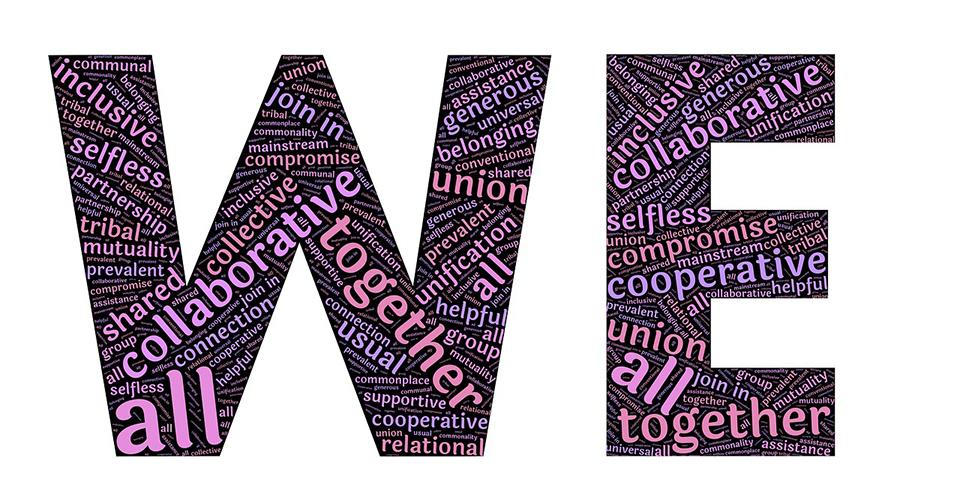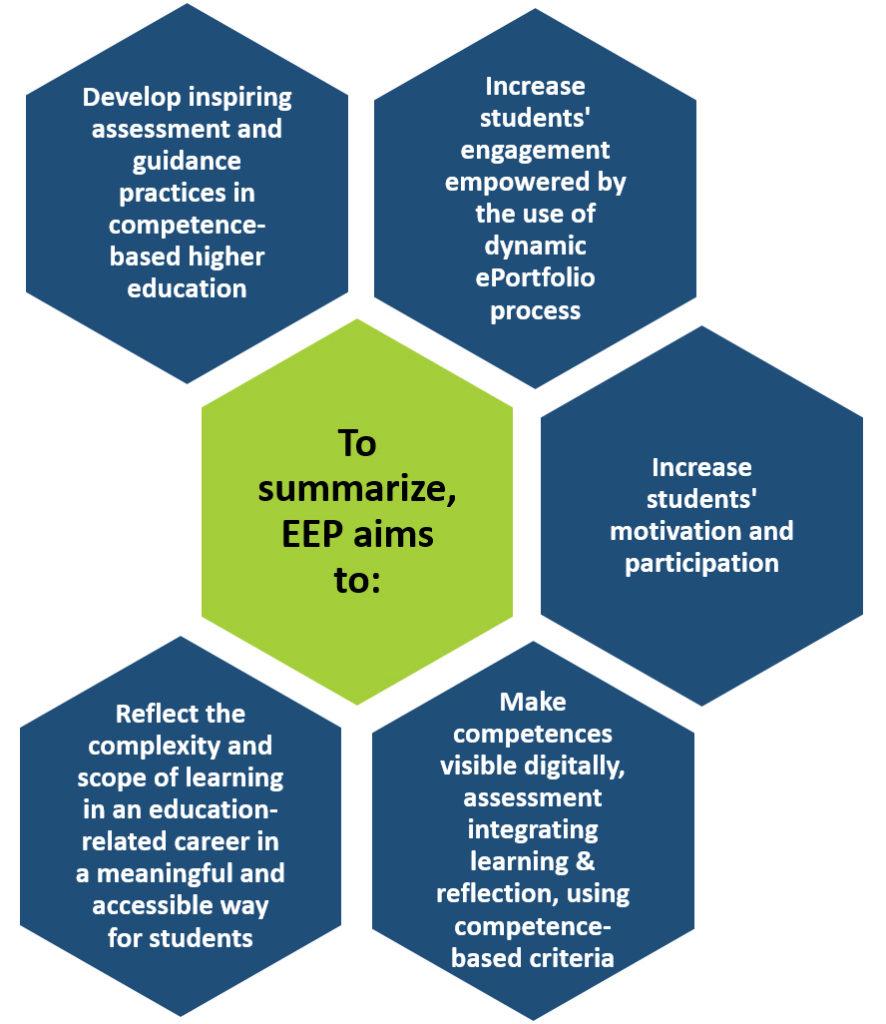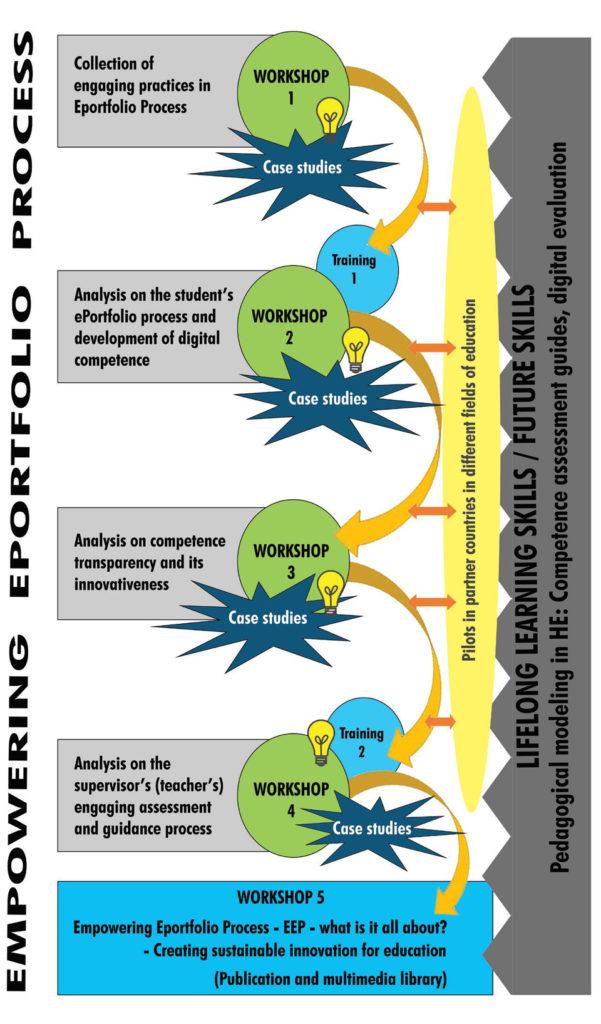
Marja Laurikainen & Irma Kunnari
This article is an introduction to the collection of articles “Empowering ePortfolio Process in Higher Education”, which is the final publication of the Erasmus+ project Empowering Eportfolio Process (EEP), funded by the European Union.EEP project has been implemented during 2016‒2018 in five countries: Finland, Denmark, Belgium, Portugal and Ireland. The partners have been investigating different aspects of ePortfolio process in higher education, namely the perspectives of students, teachers, higher education institutions, and employers. The field research conducted in partner countries on different perspectives was published in four previous publications:
1) Collection of Engaging Practices in ePortfolio Process,
2) Students’ perspectives on ePortfolios,
3) Employers’ perspectives on ePortfolios, and
4) Higher education perspectives on ePortfolios.
Introduction to the EEP project
Assessment and guidance practices aligned with desired competences are the critical points of quality in learning in competence-based education in higher education. The continuous and accelerating changes in the world of work caused by digitalization and globalization have transformed studying and working environments. In order to respond to these demands, students’ lifelong learning and career management skills as well as digital competences need to be strengthened by engaging and involving students in their own learning and assessment processes (Kunnari & Laurikainen 2017).
The need to have a digital professional profile has been recognized, but also the fact that the guidance and skills to create one, both from students’ and teachers’ side, is lacking. In addition, the assessment is more often implemented on an individual basis and merely within school environment with traditional methods. Inspiring methods such as peer and other collaborative digital assessment practices, and the creation of evidence of competences in authentic settings are not comprehensively used. Still, creativity and innovation are needed to understand how students can document and make their skills and competences transparent with digital tools (Kunnari & Laurikainen 2017).
In the framework of the EEP project:
ePortfolios are student-owned digital working and learning spaces for collecting, creating, sharing, collaborating, reflecting learning and competences, as well as storing assessment and evaluation. They are platforms for students to follow and be engaged in their personal and career development, and actively interact with learning communities and different stakeholders of the learning process. (Kunnari & Laurikainen 2017, 7.)
With this collectively created definition, the EEP project wanted to emphasize the ownership of students in the learning process and their central role in creating ePortfolios that can during the learning process be used as workspaces, and showcases when trying to find a job or connecting with the world of work (Barrett 2010).
From this starting point, six higher education institutions from five countries (Finland, Denmark, Ireland, Belgium and Portugal) began to investigate the ePortfolio process from different perspectives. The partners – Häme University of Applied Sciences, FI, project coordinator; VIA University College, DK; KU Leuven, BE; UC Leuven-Limburg, BE; Instituto Politécnico de Setúbal, PT; and Marino Institute of Education, IE – made a state-of-the-art research with existing policy initiatives, strategies and practices with ePortfolios in higher education, and beyond. In participating institutions, there was awareness for using portfolios as a methodology for recognition and guidance of learning, and all the partners had some experience in utilizing digital portfolios. The shared aim in the project was to develop the use of ePortfolios and support teachers’ professional development in the ePortfolio process, as well as to strengthen the higher education institutions’ operations and culture in recognizing prior learning and competences acquired outside formal education and training. Thus, through the improved ePortfolio process, the incongruity between competences of students and needs of the world of work should be decreased.
The main target in EEP project was to develop students’ continuous engagement in assessment and improve students’ 21st century skills and digital competences in making their professional identity transparent and steering their career management skills and lifelong learning using ePortfolio, corresponding to the EU Digital Agenda (The European Union 2014) to maximize the transformational benefits of ICT to enrich teaching. Figure 1 describes the other aims of the project.

The process of EEP was intertwined around five thematical workshops in which the partners (with some external participants as well) evaluated and discussed the fieldwork in which different perspectives of ePortfolio process was investigated by collecting data with qualitative and quantitative questionnaires, individual and group interviews, literature and policy review. The findings of the fieldwork were presented in the worskhops. Common understanding was constructed about the process, practices and tools used, which were then published in those four previous publications mentioned above: 1) Collection of Engaging Practices in ePortfolio Process, 2) Students’ perspectives on ePortfolios, 3) Employers’ perspectives on ePortfolios and 4) Higher education perspectives on ePortfolios (Kunnari & Laurikainen 2017; Kunnari & Laurikainen 2018a; Kunnari & Laurikainen 2018b; Laurikainen & Kunnari 2018).
In addition, two of these workshops included learning and training sessions that deepened the insight and mutual understanding of the partners´ pedagogical practices. The training sessions were “Building ownership of students – empowering assessment and guidance methods” and “Dynamic competence assessment process – new perspectives for university – business collaboration”. They were the basis for merging local approaches into a common understanding in order to give recommendations related to the use of ePortfolios in higher education (and beyond). The process of the EEP project is described in Figure 2.

In addition to the fieldwork, its analyses and publications, each partner had pilot activities within their own institution to investigate and develop the engaging and empowering ePortfolio process from different standpoints. The findings were collected into reports and video materials produced during the pilots.
The content of Empowering ePortfolio Process in Higher Education collection
The “Empowering ePortfolio Process in Higher Education” article collection incorporates all the perspectives of ePortfolio process into one publication and it is a comprehensive representation of highlighted findings in the EEP project. The collection provides the European level recommendations arisen from the project, highlighted findings, practical guidelines and examples of the implementation of an empowering and engaging ePortfolio process, and evaluation of the impact on different stakeholders (students, teachers, higher education institutions, employers, regional/ national/ European level decision and policy makers). In addition, the project consortium has invited some external authors and practitioners to contribute with their articles and case examples related to ePortfolio process. The authors of the collection hope that these articles provide a holistic view on the use of ePortfolios, as well as give some practical tips how to make the ePortfolio process more empowering and engaging!

This article was produced in the Erasmus+ (KA2 action) funded project “Empowering Eportfolio Process (EEP)”. The beneficiary in the project is Häme University of Applied Sciences (FI) and the partners are VIA University College (DK), Katholieke Universiteit KU Leuven (BE), University College Leuven-Limburg (BE), Polytechnic Institute of Setúbal (PT) and Marino Institute of Education (IE). The project was implementated during 1.9.2016–30.11.2018.
Authors

Marja Laurikainen, MBA, Project coordinator, Empowering Eportfolio Process – Education Development Specialist (Global Education). She currently works in global education services designing and coordinating tailored education programmes, creating cooperation and research networks with regional experts and companies.

Irma Kunnari, M.Ed (PhD Fellow in Educational Psychology) Principal lecturer, pedagogical developer and teacher educator in Häme university of applied sciences, School of Professional Teacher Education. She currently works as a project manager in Empowering Eportfolio Process (EEP) project, and has a broad experience in developing higher education and the relationships between HE institutions and the work field.
References
Barrett, H. (2010). Balancing the Two Faces of ePortfolios. Educação, Formação & Tecnologias (Maio, 2010), 3(1), 6–14. Retrieved 12 December 2017 from http://eft.educom.pt/index.php/eft/article/viewFile/161/102
European Commission (2014). The EU explained: Digital agenda for Europe. Retrieved 17 September 2018 from https://eige.europa.eu/resources/digital_agenda_en.pdf
Kunnari, I., & Laurikainen, M. (eds.) (2017). Collection of Engaging practices on ePortfolio Process. Retrieved 17 September 2018 from https://drive.google.com/file/d/0BxEnFq7yUumMUGV2V2VxVmNaNFU/view
Kunnari, I., & Laurikainen, M. (eds.) (2018a). Students’ perspectives on ePortfolios. HAMK Unlimited. Retrieved 17 September 2018 from https://unlimited.hamk.fi/students-perspectives-on-eportfolios
Kunnari, I., & Laurikainen, M. (eds.) (2018b). Higher education perspectives on ePortfolios. HAMK Unlimited. Retrieved 8 October 2018 from https://unlimited.hamk.fi/higher-education-perspectives-on-eportfolios
Laurikainen, M., & Kunnari, I. (eds.) (2018). Employers’ perspectives on ePortfolios. HAMK Unlimited. Retrieved 17 September 2018 from https://unlimited.hamk.fi/employers-perspectives-on-eportfolios





